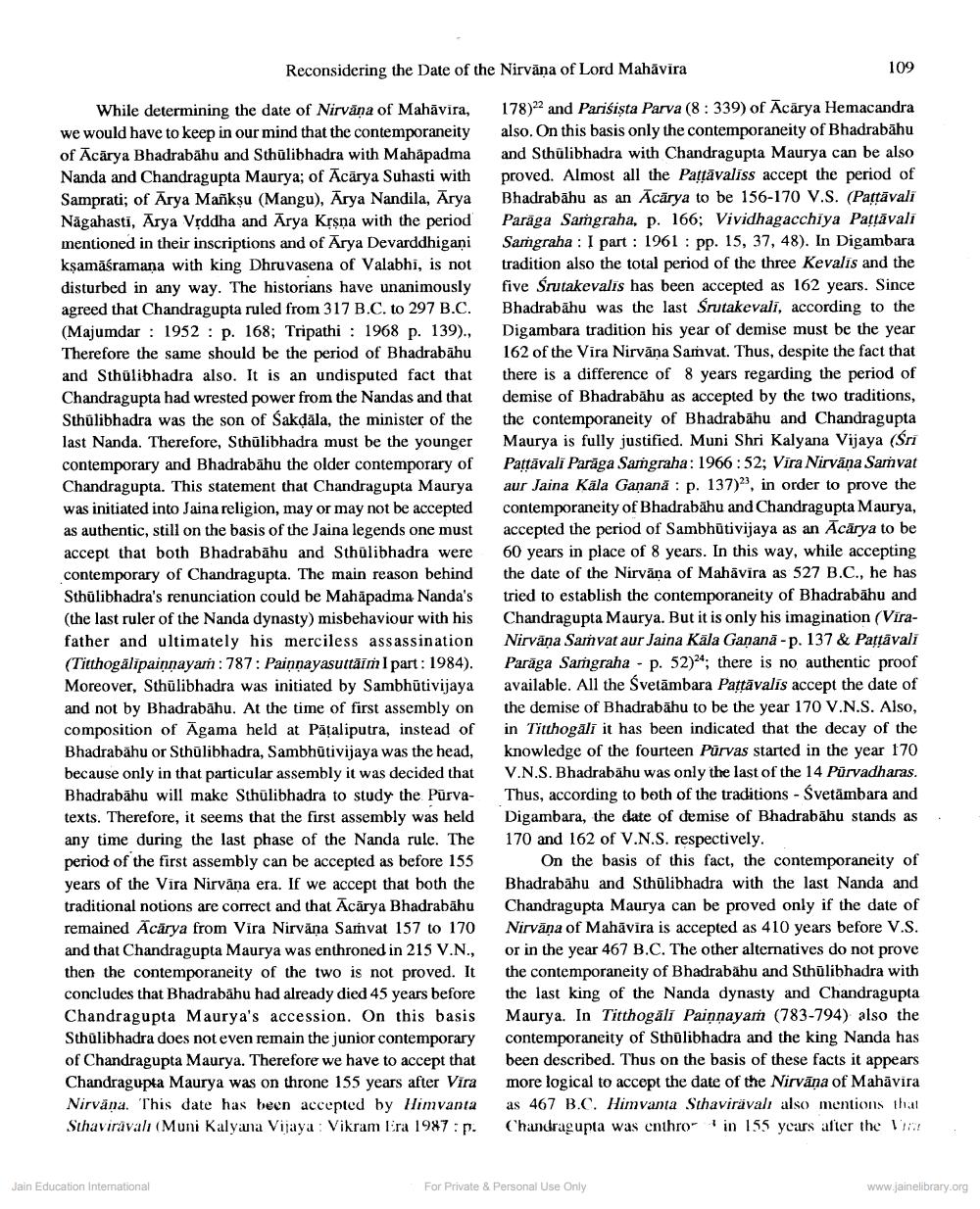________________
Reconsidering the Date of the Nirvāna of Lord Mahavira
109
While determining the date of Nirvana of Mahävira, we would have to keep in our mind that the contemporaneity of Acārya Bhadrabahu and Sthūlibhadra with Mahapadma Nanda and Chandragupta Maurya; of Ācārya Suhasti with Samprati; of Arya Mañksu (Mangu), Ārya Nandila, Arya Nāgahasti, Arya VỊddha and Arya Krsna with the period mentioned in their inscriptions and of Arya Devarddhigani kşamāśramana with king Dhruvasena of Valabhi, is not disturbed in any way. The historians have unanimously agreed that Chandragupta ruled from 317 B.C. to 297 B.C. (Majumdar: 1952 : p. 168; Tripathi : 1968 p. 139)., Therefore the same should be the period of Bhadrabāhu and Sthulibhadra also. It is an undisputed fact that Chandragupta had wrested power from the Nandas and that Sthūlibhadra was the son of Sakdāla, the minister of the last Nanda. Therefore, Sthūlibhadra must be the younger contemporary and Bhadrabahu the older contemporary of Chandragupta. This statement that Chandragupta Maurya was initiated into Jaina religion, may or may not be accepted as authentic, still on the basis of the Jaina legends one must accept that both Bhadrabahu and Sthulibhadra were contemporary of Chandragupta. The main reason behind Sthūlibhadra's renunciation could be Mahāpadma Nanda's (the last ruler of the Nanda dynasty) misbehaviour with his father and ultimately his merciless assassination (Titthogālipaiņnayam: 787: Paiņnayasuttaim l part: 1984). Moreover, Sthūlibhadra was initiated by Sambhūtivijaya and not by Bhadrabāhu. At the time of first assembly on composition of Āgama held at Pāšaliputra, instead of Bhadrabahu or Sthūlibhadra, Sambhūtivijaya was the head, because only in that particular assembly it was decided that Bhadrabāhu will make Sthulibhadra to study the Pūrva- texts. Therefore, it seems that the first assembly was held any time during the last phase of the Nanda rule. The period of the first assembly can be accepted as before 155 years of the Vira Nirvana era. If we accept that both the traditional notions are correct and that Acārya Bhadrabāhu remained Acārya from Vira Nirvana Samvat 157 to 170 and that Chandragupta Maurya was enthroned in 215 V.N., then the contemporaneity of the two is not proved. It concludes that Bhadrabahu had already died 45 years before Chandragupta Maurya's accession. On this basis Stholibhadra does not even remain the junior contemporary of Chandragupta Maurya. Therefore we have to accept that Chandragupta Maurya was on throne 155 years after Vira Nirvana. This date has been accepted by Himvanta Sthaviraval (Muni Kalyana Vijaya: Vikram Era 1987:p.
178)22 and Parisista Parva (8 : 339) of Ācārya Hemacandra also. On this basis only the contemporaneity of Bhadrabāhu and Sthulibhadra with Chandragupta Maurya can be also proved. Almost all the Pattāvaliss accept the period of Bhadrabāhu as an Acārya to be 156-170 V.S. (Pattāvali Paråga Samgraha, p. 166; Vividhagacchiya Pattavali Samgraha : I part: 1961: pp. 15, 37, 48). In Digambara tradition also the total period of the three Kevalis and the five Śrutakevalis has been accepted as 162 years. Since Bhadrabāhu was the last Srutakevali, according to the Digambara tradition his year of demise must be the year 162 of the Vira Nirvana Samvat. Thus, despite the fact that there is a difference of 8 years regarding the period of demise of Bhadrabahu as accepted by the two traditions, the contemporaneity of Bhadrabāhu and Chandragupta Maurya is fully justified. Muni Shri Kalyana Vijaya (Sri Pattāvali Parăga Sangraha: 1966:52; Vira Nirvana Sarvat aur Jaina Käla Ganană : p. 137)2), in order to prove the contemporaneity of Bhadrabahu and Chandragupta Maurya, accepted the period of Sambhūtivijaya as an Acārya to be 60 years in place of 8 years. In this way, while accepting the date of the Nirvana of Mahavira as 527 B.C., he has tried to establish the contemporaneity of Bhadrabāhu and Chandragupta Maurya. But it is only his imagination (ViraNirvana Samvat aur Jaina Kala Ganana - p. 137 & Pattavali Parāga Samgraha - p. 52)24; there is no authentic proof available. All the Svetāmbara Pattavalis accept the date of the demise of Bhadrabāhu to be the year 170 V.N.S. Also, in Titthogāli it has been indicated that the decay of the knowledge of the fourteen Purvas started in the year 170 V.N.S. Bhadrabahu was only the last of the 14 Pürvadharas. Thus, according to both of the traditions - Svetämbara and Digambara, the date of demise of Bhadrabāhu stands as 170 and 162 of V.N.S. respectively.
On the basis of this fact, the contemporaneity of Bhadrabahu and Sthülibhadra with the last Nanda and Chandragupta Maurya can be proved only if the date of Nirvana of Mahāvira is accepted as 410 years before V.S. or in the year 467 B.C. The other alternatives do not prove the contemporaneity of Bhadrabahu and Sthūlibhadra with the last king of the Nanda dynasty and Chandragupta Maurya. In Titthogali Painnayam (783-794) also the contemporaneity of Sthulibhadra and the king Nanda has been described. Thus on the basis of these facts it appears more logical to accept the date of the Nirvāna of Mahävira as 467 B.C. Himvanta Sthavirävalı also mentions that Chandragupta was enthro in 155 years after the 11
Jain Education International
For Private & Personal Use Only
www.jainelibrary.org




